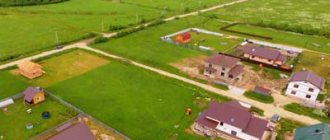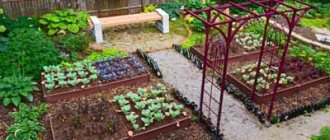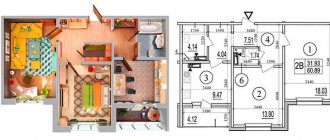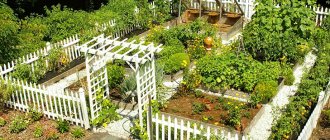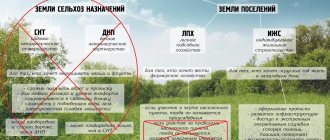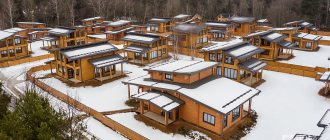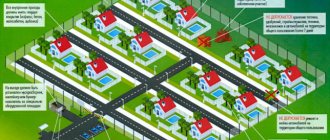When purchasing a plot of land, it is important to know many nuances. Not everyone can build a house on which to live with their family all year round. For example, on one site you can build a cottage, and on another - only a country house. It all depends on what property and classification the land plot belongs to. In addition, its value, amenities, and the possibility of registration depend on the status of the land. In the article we will analyze the decoding of the abbreviations IZHS, SNT and others. Let us explain the features, advantages and disadvantages of these types of classification of land plots.
Individual housing construction plot: what is it?
IZHS stands for individual housing construction
. Areas with this status are located within populated areas - with the appropriate infrastructure. In accordance with Article 48, paragraph 3 of the Town Planning Code of the Russian Federation, a permanent residential building can be erected on a land plot with this status, the main thing is that the height should be no more than 3 floors.
Advantages of individual housing construction
The main advantage of a land plot for individual housing construction is the ability to register at the place of residence
, however, only after the construction of a residential building.
Other advantages are:
- banks are willing to issue a mortgage for the purchase of land for individual housing construction;
- in settlements with developed infrastructure there will be no problems enrolling a child in school or kindergarten;
- the owner of the house has the right to freely connect to the main communications (in practice this is quite rare);
- there is an opportunity to use all social services and privileges (if available).
In addition, when purchasing such an object, you can apply for a property deduction for personal income tax.
, but only subject to the official employment of the owner of the plot for individual housing construction.
Disadvantages of land for individual housing construction
In accordance with the legislation of the Russian Federation, each region has certain restrictions on the size of plots
for individual housing construction. And before the construction of a facility, all necessary documents (acts, projects and other papers) must be approved by the relevant government authorities.
What is prohibited on individual housing construction sites
The legislation establishes certain prohibitions regarding the use of sites with this status. Owners are prohibited from producing or selling ritual goods or organizing the processing of agricultural products (for the purpose of making a profit).
It is forbidden to build facilities for industrial or municipal use on plots for individual housing construction.
.
How to transfer SNT to individual housing construction?
To change the status of a territory, you must contact the land chamber of the administration in which the object is located. Those. if it is a city, then to the city, village - rural or regional.
The basis for changing the status of a site is the owner’s decision, but we must not forget about other conditions:
- Consent of all owners if the land is divided into shares between several persons;
- The administration agrees that there are no plans to sow the land or carry out agricultural work on it.
To transfer SNT to individual housing construction, you must provide the following documents:
- Cadastral passport of the site;
- A document confirming ownership of the plot;
- Document confirming the identity of the owner;
- Notarized power of attorney of land shareholders, if the plot is divided into shares between several persons.
After submitting the documents, the owner will receive a response within 1-2 months. In case of refusal, the procedure must be repeated.
Typically, the administration’s refusal is a consequence of:
Errors in documents;- Providing an incomplete package of documents;
- The administration has plans to use the land for agricultural needs.
- It is worth answering that only in the first two cases, it is possible to receive a positive answer upon repeated application and the owner should send a repeated request to the Land Chamber. Since in case of refusal due to the use of agricultural land for its intended purpose, a positive answer will not be given until the transfer of the entire SNT to individual housing construction.
How much does it cost?
The price of services for transferring SNT to individual housing construction depends on:
- The region in which the site is registered;
- Availability of intermediaries.
The cost of services of lawyers lobbying for the process of changing the status of an object can increase the price of services for changing the legal status of a site by 2, 3 times.
- The average price in Russia is 15,000 thousand rubles, when contacting a law firm - 30,000/45,000 thousand rubles.
However, with the participation of intermediaries, the owner will not have to stand in lines to obtain the necessary documents. All time costs, as well as the responsibility to draw up a package of documents and submit it to the administration, fall on the shoulders of the lawyer. In case of refusal, the lawyer is obliged to correct all existing errors and fulfill the requirements of the administration, as well as resubmit the papers.
SNT: what is it
SNT stands for garden non-profit partnership
. Lands with this status are located outside populated areas; initially such areas were intended for agriculture. The owner of the site becomes a member of the partnership, so he must regularly pay membership fees and can take part in meetings.
Advantages of SNT lands
Compared to individual housing construction lands, plots in SNT are much cheaper
. They are located, as a rule, in rural areas - that is, in areas with good ecology.
Disadvantages of SNT
It is not prohibited to build residential buildings on plots in SNT, but they will be considered country houses
, even if someone lives in them all year round. This is justified by the status of such a site.
Other disadvantages:
- plot owners provide all necessary communications at their own expense;
- It is difficult to register in a built house;
- a plot in SNT, as a rule, has an area of no more than 15 acres.
Another important disadvantage is that banks are reluctant to take land in SNT as collateral
– this complicates the process of acquiring it if there are no savings.
Is it possible to transfer SNT to individual housing construction?
The opportunity to transfer SNT into individual housing construction appeared quite recently, but today there are already many cases of transferring territories from one organizational and legal status to another.
The main reasons why owners want to change the status of the territory they own are:
- The desire to use maternal capital to build a house. Since state assistance can only be used on plots of the individual housing construction category.
- Desire to get a loan to build a house. Since banks prefer to subsidize only construction in individual housing construction, since the development plan for private household plots and SNT is not regulated and this leads to high risks.
- Desire to register at the site for permanent residence. This opportunity is only available for individual housing construction lands.
There are conditions for transferring SNT to individual housing construction:
- The territory should not be located at a great distance from communications - the land should be located on the territory of the settlement;
- The administration should not plan to use the territory for future agricultural work - the land should not have the status of “agricultural use”;
DNT: what is it?
DNT stands for dacha non-profit partnership. When purchasing a plot of land with this status, you will need to pay membership fees, since each owner becomes a member of the association of owners. All decisions related to the supply of communications, the purchase of equipment and other means/materials for common use are made at general meetings.
In accordance with Federal Law No. 66 “On horticultural, gardening and dacha non-profit associations of citizens”, country houses and outbuildings can be built
for storing equipment. It is allowed to engage in agriculture and personal farming.
Benefits of DNT
The main one is low cost
. The sites can be located both within the city and outside it. As a rule, the lands are fertile and located in ecologically clean areas. The owner of the site can erect buildings at his own discretion.
Disadvantages of DNT
These include the following:
- remoteness from main social facilities;
- difficulty in connecting communications (it will not be possible to connect them without a general meeting);
- the need to constantly pay membership fees and attend board meetings.
But if we look in more detail, such shortcomings will not become an obstacle to the acquisition of a small suburban plot in an environmentally favorable area.
What is their fundamental difference?
To answer this question, you need to look into Russian legislation. Plots belonging to the DNP are considered agricultural land, and the same individual housing construction is usually considered development within the city limits. The first type is several times cheaper. Thanks to the new law, individual housing construction with DNP is almost equal in value. On dacha plots, it is now possible to build an individual house to live in permanently.
DNP: what is it?
DNP is a dacha non-profit partnership
. Plots with this status are excellent for building a country house. As a rule, the lands are located outside the city limits. But they are also found within populated areas, which largely equates them to sites for individual housing construction. The owner of a plot in the DNP is a member of such a partnership, and his responsibilities include regular payment of membership fees.
Advantages of plots in DNP
on such plots , but without the right to recognize it as residential
. That is, even if you build a house for year-round use, it will not be possible to obtain the status of a residential property for it. The cost of plots in DNP is lower than for individual housing construction, but there are certain nuances here too.
A permanent structure may be located on the site - therefore, the cost of the land together with the facility in some cases exceeds the cost of the plots for individual housing construction. If the site is located within the boundaries of a populated area, you can register in the house. Justification: Resolution of the Constitutional Court of the Russian Federation No. 7-P dated April 14, 2008.
Disadvantages of DNP sites
They are the same as for sites in SNT and DNT:
- difficulties in purchasing a plot or building with a mortgage;
- providing communications at your own expense;
- difficulties in designing a permanent house as a residential property;
- There is no way to register.
This plot can only be used for agricultural purposes.
. Also, do not forget that if the site is located outside the populated area, there will be problems with registering children for schools and kindergartens, as well as using other advantages of city residents.
Dacha non-profit partnership: what it is and what it is intended for
First of all, you need to know that a dacha non-profit partnership can be created either on the territory of an existing settlement or on agricultural lands that do not belong to settlements.
Important: for any dacha construction you need to obtain a special permit.
Since the dacha partnership is a non-profit organization, it is founded taking into account all the principles for establishing such associations. The law defines such a partnership as a legal entity. First, the participants of the organization (there must be at least three people) are required to decide where exactly the DNP will be located. In addition, they must:
- determine the purpose of creation;
- give your organization a name;
- pay the state fee;
- have a copy of the DPP Charter.
The dacha partnership has a certain structure, including a controlling body - a meeting of members of the dacha. The financial activities of the organization are checked by the audit commission. Participants in a dacha partnership have the right to resolve the following issues:
- election of the executive body of the organization;
- reorganization of the DNP;
- use and formation of all property of the DNP;
- acquisition of plots, etc.;
- changes that need to be made to the charter of the dacha partnership.
Private plots: what is it?
LPH stands for personal subsidiary plot
. Sites with this status can be located both within the city limits and outside it.
Depending on this, their purpose is determined, as well as their area of use. If the plot is located within the city limits, it can be transferred to individual housing construction. This will increase its value and also make it possible to erect a residential building on it with the right to register it. If the site is located outside a populated area, building a house on it is prohibited.
Such lands are allocated only for agricultural work.
Advantages of private plots
If the site is located within the boundaries of a populated area, banks are willing to issue loans for it. You can conduct farming activities on it
– this is not entrepreneurship if everything happens on plots of private household plots (and therefore is not subject to taxes).
Disadvantages of private plots
It is prohibited to erect buildings in areas located outside populated areas
. In addition, the land is issued in the form of shares on which something will have to be grown.
How much does it cost to re-register land?
Our state guarantees a free change of VRI allotment, as well as its transfer from one category to another. At the same time, the preparation of a package of accompanying documents will require payment of a state fee and the services of a cadastral engineer.
Basic financial expenses:
- Registration of an extract from the Unified State Register – from 300 to 600 rubles. – in electronic form, from 750 to 2200 rubles. – a paper extract with a live stamp.
- Land surveying - from 7,000 rubles. depending on the region of work.
- Making changes to the Land Cadastre – from 245 to 700 rubles. – the application is submitted electronically, from 350 to 1000 rubles. – direction of the “paper” package of the document.
The solution to this problem can be entrusted to a lawyer.
The deadline for completing the work in this case will not change, but the cost will increase by 20-50 thousand rubles .
Advantages and disadvantages of DNT
The advantages of such areas:
- The cost of land is lower compared to SNT and individual housing construction.
- The proximity of nature, the opportunity to experience the delights of rural life.
- Collective solution of life support issues (electricity, water supply, etc.).
- The house will not have to be recognized as residential, even if it is strong enough for permanent residence.
The disadvantages of DNT relate to the following aspects:
- It will be difficult to build a permanent house, since the site is intended for growing crops, and not for permanent housing.
- Bringing roads, electricity, gas and other communications to the dacha plot is paid and can be very expensive for the owner.
- To register in the house, you will have to contact the BTI, FMS, and conduct an examination of the dacha.
- There are no clinics, schools or other institutions in the DNT territories. You will have to take your child to classes or make an appointment with a doctor in the nearest locality.
- Banks are reluctant to accept land plots as collateral when applying for a mortgage.
Not everyone will like living in a house located on the territory of the DNT, since there are few infrastructure facilities nearby (shops, schools, medical institutions). To resolve many issues, you will have to find a common language with your neighbors.
DNT plot: what are the problems with buying/selling
The information provided by the seller is not always true, or the owner still has debts to the partnership. Therefore, before purchasing a DNT site, it is important to carefully study the documentation for the site and check the seller’s details. It is advisable to personally go to the specified area.
The seller of DNT land must have a complete package of documents to complete the transaction:
- cadastral passport;
- certified technical construction plan;
- an extract from the Unified State Register of Real Estate on state registration of ownership of a land plot and a house;
- a certificate from the DNT board confirming that the seller has no debts;
- an extract from the Unified State Register confirming the absence of encumbrances and prohibitions;
- boundary plan of the site (if you have any doubts).
Legal registration of real estate and registration on the site is possible only if the DNT village itself is organized legally.
Difficulties may arise when purchasing land with an unfinished house in DNT, and various: from improper location on the site to problems with construction. Sometimes demolishing and creating a new house is easier than finishing the old one.
It happens that after purchasing land, sellers take away building materials (buildings) from plots that they did not sell under the contract. Therefore, it is important to ask to register an unfinished house.
In problem-free situations, the owners register the house in their name immediately after purchase.
Why are owners of such plots most often sued?
The relationship between DNT participants and managers and power engineers is a zone of ongoing conflict. In arbitration courts, more than half of the cases involving dacha partnerships are either claims against network companies or from them.
DNT courts often drag on for a long time due to complaints from residents against the chairmen. The latter steal money from the general account or do not fulfill the promised conditions, violating the rights of DNT owners and the charter.
